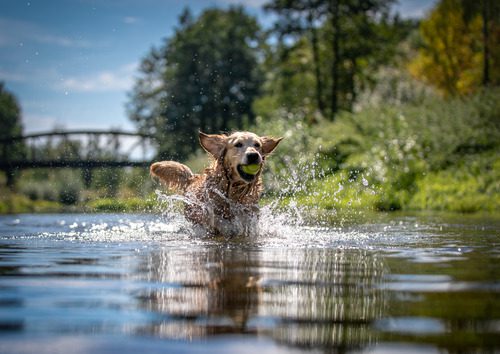Blue Green Algae in Dogs: Everything You Need to Know
Warm weather, lakeside strolls, and outdoor play can make summer the highlight of the year for many dogs. But hidden dangers can lurk in places that seem harmless, especially in and around freshwater. Blue green algae is a naturally occurring toxin that can pose a significant threat to your pet’s health, even with minimal exposure. Understanding how to spot and avoid blue green algae in dogs can help you protect your pet when enjoying time outdoors. If you frequent local lakes, ponds, or streams near Clifton Park, NY, this blog is for you. Read on to learn what blue green algae is, why it’s dangerous, where it’s commonly found, and what to do if you suspect your dog has been exposed.

What Is Blue Green Algae in Dogs?
Blue green algae, also called cyanobacteria, are microscopic organisms that live in freshwater. Despite their name, they aren’t algae at all. They are photosynthetic bacteria that tend to multiply quickly during warm weather, especially in stagnant or slow-moving water. When conditions are right with warm temperatures, lots of sunlight, and excess nutrients, blue green algae can form blooms that appear as scum, foam, or mats floating on the surface of lakes or ponds. These blooms often give the water a blue, green, brown, or reddish appearance and can emit a foul odor.
While not all blue green algae produce toxins, the ones that do can be extremely dangerous to dogs. Dogs can be exposed through swimming, drinking contaminated water, or licking algae from their fur. Because dogs often explore with their mouths, they’re at a much higher risk of accidental ingestion than people.
Why Is Blue Green Algae Dangerous for Dogs?
When dogs come into contact with blue green algae, they may be exposed to harmful toxins that affect various body systems. These toxins can cause rapid and severe health issues, often within minutes to hours after exposure.
Types of Toxins in Blue Green Algae
There are several types of toxins produced by cyanobacteria that affect dogs differently:
- Hepatotoxins: These target the liver and are among the most dangerous. Symptoms can include vomiting, diarrhea, lethargy, jaundice, and even liver failure.
- Neurotoxins: These affect the nervous system and may cause muscle tremors, difficulty walking, paralysis, or seizures.
- Dermatotoxins: These can cause skin irritation, rashes, or allergic reactions, although they are less commonly seen in dogs compared to the other toxin types.
Even a small amount of toxin exposure can be life-threatening. Unfortunately, once symptoms start, the situation can escalate quickly.
Where and When Blue Green Algae Blooms Happen
While blue green algae can appear any time the conditions are right, they’re most commonly found in the late spring through early fall when water temperatures are warmer. In Clifton Park and across New York, blooms often occur in freshwater lakes, ponds, reservoirs, and slow-moving streams.
High-Risk Locations
Dogs are most at risk near:
- Still or stagnant water: Ponds, ditches, and small lakes with minimal flow are ideal conditions.
- Areas with agricultural runoff: Excess nutrients from fertilizers and manure can fuel algae growth.
- Shorelines with visible scum: If you see green or blue film, thick mats, or a pea soup-like appearance, stay away.
It’s also important to remember that not all blooms are visible. Water can appear normal while still harboring toxic algae.
Signs of Exposure to Blue Green Algae in Dogs
Knowing the signs of exposure to blue green algae in dogs can help you act quickly. Symptoms vary depending on the toxin type and the amount ingested but often appear rapidly.
Early Warning Signs
- Vomiting and diarrhea (may be bloody)
- Drooling or excessive salivation
- Weakness or lethargy
- Difficulty breathing
- Disorientation or stumbling
- Tremors or seizures
- Yellowing of the eyes or skin (jaundice)
- Collapse
In some cases, dogs may show signs within 15 minutes of exposure. Immediate veterinary care is essential for giving your pet the best chance of recovery. If you suspect your dog may have come into contact with blue green algae, contact Cornerstone Veterinary Hospital of Clifton Park right away at (518) 383-6254.
How to Avoid Blue Green Algae in Dogs
Prevention is the best way to protect your dog from blue green algae. Awareness and caution during outdoor adventures go a long way.
Tips to Stay Safe During Outdoor Activities
- Avoid letting your dog swim in or drink from stagnant water, especially during the summer months.
- Keep your dog leashed near lakes, ponds, or rivers unless you are sure the water is safe.
- Check for posted warnings about harmful algal blooms. Many parks and municipalities monitor for algae and post signs when blooms are detected.
- Visually inspect the water for signs of scum, discoloration, or foul odor. If the water looks questionable, don’t take chances.
- Rinse your dog thoroughly with clean water after swimming, especially if they’ve been in natural bodies of water.
- Bring fresh water on walks, hikes, or outings, so your dog isn’t tempted to drink from lakes or puddles.
How Blue Green Algae in Dogs Is Diagnosed and Managed
Veterinarians rely on clinical signs, recent exposure history, and diagnostic testing to evaluate a dog suspected of blue green algae poisoning. While there’s no specific antidote for blue green algae toxins, supportive care may help manage symptoms and stabilize the patient.
Diagnostic Considerations
- History of exposure: If you were near a body of water recently, that information is critical.
- Clinical symptoms: Liver damage, neurological signs, and gastrointestinal upset can point toward toxin exposure.
- Laboratory tests: Bloodwork and urinalysis may show elevated liver enzymes, electrolyte imbalances, or organ dysfunction.
Treatment Approach
Because the toxins act quickly, early intervention is essential. Treatment may include IV fluids, medications to control symptoms, and supportive therapies to help the liver and nervous system. The prognosis depends on how much toxin was ingested and how soon treatment begins.
Why Fast Action Matters
Blue green algae in dogs can be deadly. If you suspect any contact through swimming, drinking, or licking algae-contaminated fur, act immediately. Quick action and professional veterinary support can be life-saving. Even if your dog appears fine after exposure, don’t wait for symptoms to appear. Early care often makes a difference in the outcome. If you’re near Clifton Park, NY, call Cornerstone Veterinary Hospital of Clifton Park at (518) 383-6254 or request an appointment as soon as possible.
Protecting Your Dog During Warm-Weather Adventures
Blue green algae in dogs is a serious health concern, especially during the warmer months when outdoor water activities become more frequent. Although the idea of a toxic bloom might sound rare, these events are becoming more common in many parts of the country, including Upstate New York. Knowing where the risks lie and how to avoid them can make summer safer for your pet. Always keep a close eye on water conditions, provide plenty of clean drinking water, and when in doubt, steer clear of unfamiliar lakes or ponds. If you have any questions or concerns, the team at Cornerstone Veterinary Hospital of Clifton Park is happy to help. Call us today at (518) 383-6254 to speak with a member of our team or schedule an appointment.
Recent Posts
Benefits of Spaying or Neutering a Cat
Benefits of Spaying or Neutering a Cat Deciding to spay or neuter your cat is a responsible…
Why Does My Cat Get Eye Boogers Everyday?
Why Does My Cat Get Eye Boogers Everyday? Cats are known for their meticulous grooming habits, but…
Why Do Cats Like Christmas Trees?
Why Do Cats Like Christmas Trees? Christmas is a magical time of year filled with twinkling lights,…
About Us
Originally opened as Animal Care Hospital by Dr. Mark Johnston in 1989, the hospital became Cornerstone Veterinary Hospital in 2015 when it was purchased by Drs. Alan and Lisa Knott. The name 'Cornerstone' holds a special place in their hearts, representing not only their Christian faith but also their commitment to being the cornerstone of the community in which they practice. As a family-owned and operated practice, every pet is treated as part of the family, ensuring they receive the highest standard of care. The team at Cornerstone Veterinary Hospital is dedicated to building lasting relationships with clients and their beloved pets, striving to be the cornerstone of the community in which they practice.



